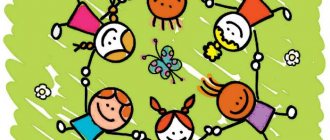When a second baby appears in the family, the daily routine of the first-born child most often undergoes changes. The mother can no longer let the alternation of periods of sleep, wakefulness, nutrition and developmental activities take their course and tries to create a daily routine for the child that will be as close as possible to the regime of the youngest member of the family.
The peculiarities of life with two children are such that at first it seems to you that balancing the daily routine of two children is an impossible task. If the first months after birth, the daily routine of a mother of two children resembles chaos, then when the baby determines for himself almost constant periods of sleep and wakefulness (which happens around six months), it is already possible to systematize the day, outlining the main milestones. And so, over time, you realize that even two children so different in age have moments of contact that are convenient for creating your family routine.
Why do you need a daily routine in a child’s life?
It would seem, why do you need a daily routine for children if they do not go to kindergarten, and you are a supporter of creative and free development? But with the advent of a second child, the need for a clear sequence of actions appears even in the most disorganized parents. It is a calm, tailored to individual child’s daily routine that allows mom and dad to plan household chores and free up some precious time for themselves and each other.
Komarovsky and Pavlov, recognized gurus of Russian pediatrics, convince us that a child needs a regulated daily routine. But Western pediatric doctors also agree with the need for a clear sequence in organizing the day for young children.
A good daily routine in a child’s life is a certain order of life, which provides for the alternation of periods of sleep and wakefulness, the rational organization of his play and educational activities. A well-designed regimen helps strengthen children’s nervous system, good health, reduces fatigue and provides all the child’s needs. It is necessary to understand that the daily routine for children is not a rigid framework, but a condition under which all the needs of children are taken into account and they feel confident knowing what will follow. As a rule, deviations in the sequence of actions do not exceed 20-30 minutes.
Daily routine of preschoolers in preschool and at home
February 16, 2021 A daily routine is a clear routine of life during the day, which includes alternating wakefulness and sleep, as well as the rational organization of various types of activities. A correct regimen that corresponds to the child’s age strengthens health, ensures efficiency, successful implementation of various activities, and prevents overwork.
In a child accustomed to a routine, the need for food, sleep, and rest occurs at certain intervals and is accompanied by rhythmic changes in the activity of all internal organs. The body, as it were, adjusts in advance to the upcoming activity, so it is carried out quite efficiently, without unnecessary waste of nervous energy and does not cause pronounced fatigue.
It is known that every preschool educational institution has a daily routine. Sleep, games, meals and activities are carried out at strictly defined hours. Before sending the baby, parents should arrange the daily routine at home in such a way that sleep and meal times fall at the same hours as in kindergarten. To do this, fathers and mothers need to know what the routine is in a preschool education institution.
The daily routine in a preschool educational institution is organized in such a way that children, depending on their age, have enough time for active games, activities and relaxation. The child’s daily routine may be different, but each preschool education institution adheres to the same general rules.
Free activity time is provided for independent games. Children also play with each other while walking outdoors. If the weather is bad outside, then instead of going for a walk, children spend time in a group.
Not only the timing of meals, but also the composition of the dishes plays a huge role in the daily routine. An approximate menu must necessarily include: dairy products, vegetables, fruits, meat and fish products, bread. Parents can ask in advance what their children are fed in a particular institution.
During quiet time, all children rest. Even if the child does not want to sleep during the day, he simply lies on the bed. As a rule, daytime sleep time is from 2 to 2.5 hours.
Activities are of great importance for the full development of a child. The duration of classes, as a rule, does not exceed 30 minutes, so that the child does not have time to get tired.
The daily routine not only in preschool, but also at home on weekends is of great importance for the health and physical development of children. Consistent time for eating, sleeping, walking, playing and studying is very important for a preschooler.
One of the important distinguishing features of education in kindergarten from home education is the lifestyle. In kindergarten, everything is subject to a pre-established routine. And this is a definite plus. After all, such systematicity accustoms the child to neatness, precision, and order. Eating the right amount of food at the same time promotes the growth of a healthy body.
A child’s behavior in kindergarten, his mood, and performance are directly dependent on how his activities and sleep are organized in the family on regular days and also on weekends.
Children spend their weekends at home, as a rule, with significant deviations and even violations of the usual kindergarten routine. It is no coincidence that the functional level of preschoolers on Monday is worse than on the second and third days of the week. Serious organizational and educational work is needed among parents to streamline the home regime and bring it into line with that established in kindergarten. Parents' attention should be drawn to organizing an evening walk, a night's sleep, and on weekends to proper rest in the air, and regulating the viewing of television programs, especially before bedtime.
Dear parents, remember that proper physical education, combined with a daily routine that meets hygienic requirements, sufficient sleep and reasonable nutrition, is the key to the normal growth and development of a child. For children raised in kindergarten, the day is subject to a strict schedule with provided walks and outdoor games, gymnastics, rhythm classes, etc. You, the parents, only have to make sure that at home, on weekends, the schedule does not differ from what was established in kindergarten and which has become familiar to the child. If a son or daughter is being raised at home, it is also necessary to develop a strict regime and monitor its strict implementation. They should go to bed and get up at the same time, go for walks - this is important for the normal, harmonious development of your child.
If your child does not go to kindergarten and stays at home, then there can be many variations of the day. One way or another, the child’s daily schedule is divided into two parts: “before lunch” and “after lunch”. Before lunch, it is useful for your child to play active educational games, and after lunch we recommend that you read books, watch cartoons or children's programs. It is best to set aside evening time for the child to communicate with his parents: at this age, the child’s need to communicate with mom and dad is very great. Stories, not always true, but instructive, will interest your child and, with the help of vivid images that impress children so much, will remain for life as rules and stereotypes of behavior in certain life situations.
Good luck raising your child!
We bring to your attention an approximate daily routine at home:
- Awakening, morning exercises, water procedures 7.00-8.00
- Breakfast 8.00-9.10
- Games and activities at home 9.10 -10.00
- Walk and games in the fresh air 10.00-12.30
- Lunch 12.30-13.20
- Daytime nap 13.20-15.30
- Free time for quiet games 15.30 -16.00
- Afternoon tea 16.00-16.30
- Walk and games in the fresh air 16.30-18.30
- Dinner 18.30-19.00
- Free time, quiet games 19.00 -21.00
- Night sleep
Source
Benefits of a daily routine for a child
- Eating meals at the same time every day helps you avoid any digestive problems. This is what has always distinguished children of noble blood - careful adherence to the times of breakfast, afternoon tea, lunch and dinner.
- Compliance with the regime has a beneficial effect on the child’s health. He gets enough sleep, food, fresh air, emotional, physical and mental stress.
- Doctors unanimously say that the immunity of a child who follows a daily routine is higher. The subconscious tends to quickly learn that there is a time for everything, and the appetite awakens at just the right time, and sleep comes faster and becomes deeper.
- The procedure allows parents to plan at least something ahead. This helps to avoid chaos, disorder, fatigue and the inability to influence your life.
- Children who live according to a routine are calmer and more confident. They feel daily stability and confidence in the future. After all, kids are still conservatives, and when their life together with their parents’ is chaos, they feel anxiety and helplessness to predict the course of events.
- If children are accustomed to living, observing an approximate daily routine, they have fewer questions for their parents, and there is no pressing need to constantly command and tell the kids what to do.
- Since kindergartens and schools adhere to a routine, adherence to the routine greatly contributes to the rapid adaptation of children to an educational institution.
- A daily routine lays the foundation for self-discipline, which will be useful for children as they enter adulthood.
Systematic distribution of waking time, normalized sleep, nutrition and activities, strict adherence to hygiene procedures - all this allows the child to be calm, confident and cheerful. As a rule, a violation of the daily routine immediately affects the kids - they become either hyper active, excited, or whiny and lethargic. They may lose their appetite, be capricious, and have trouble falling asleep.
Thus, we determine the need to maintain a daily routine for both mother and both children. All that remains is to bring it closer and match the rhythms of your older child and baby.
Are there any disadvantages to the daily routine?
The disadvantages of a daily routine, or, more precisely, objections to following a strict daily routine, are as follows:
- kids often get out of their usual routine, disrupting the sequence and timing of events. Their sleep and nutrition are easily disrupted by external factors (weather, physical or mental discomfort, changes in the type and method of feeding);
- children can intuitively follow their needs. This is the basis of the objection to forced obedience to a schedule;
- Strict adherence to the daily routine, ignoring individual living conditions, personality traits and age can lead to rigidity of thinking, inability to adapt to changes in the environment, deprivation of individuality and also to health problems.
Key points in organizing the day and routine for two children
Most often, the final daily routine of a mother with two children develops when the youngest reaches the age of one and a half years. Oddly enough, the daily routine of a mother of the same age or twins fits in somewhat more easily, since the children are similar in their needs. But even in this case, the child’s daily routine can vary greatly depending on his personality and temperament.
In the first years of life up to three years, the child’s daily routine changes more than once. But the four years remaining before school almost do not affect the daily routine. With each stage, the amount of sleep required per day decreases, and the food acceptable to the baby changes.
It is worth noting that until the routine of a breastfed baby stabilizes, it is not possible to combine it with the daily routine of an older child. But if gradually the main events in the life of a baby, such as eating, walking, bathing, sleeping, happen one after another, then the child will quickly get used to it and will be happy to follow the routine. Well, force majeure, which always occurs, will be something rare and not terrible.
The most important thing, when connecting the daily routine of young children, is to take into account what the older child will do and what the younger child will do. If you try to follow the sequence of actions for at least about a month, the rhythm of life will become familiar and desirable for all family members.
Do not forget that the daily routine is a very, very flexible concept. As each child matures and grows, he can, and should, change. Each of the children experiences a transition to two and then three sleeps a day, a change in the quality and quantity of food, and the number of activities.
The main components that you should focus on when creating a daily routine for the whole family are:
- Dream
- Walk
- Classes
- Play activity
- Rest and free time
- Eating
- Hygiene procedures
It is these main points that should be taken into account when developing your own daily routine for the child, mother and baby, changing the duration and content of the components, including the child’s sleep pattern, depending on the age and needs of the children.
Table of daily routine according to Komarovsky
Outline of an open lesson “Student’s daily routine”
- January 28, 2016
“Only the person himself can achieve and maintain health” (N. Amosov)
Purpose of the lesson : to form in students the concept of a daily routine that ensures human health.
Tasks:
1. Develop healthy lifestyle skills.
2. Familiarize students with the concept of daily routine.
3. Promote the development of responsibility for your health and the health of others.
Equipment: Laptop, presentation about daily routine, visual materials.
Progress of the lesson
Early in the morning someone strange looked into my window. A bright red spot appeared on the palm. This sun looked in, as if it had extended its hand, a thin golden ray. And like with your first best friend, you greeted me! Teacher: The sun greets each of us with warmth and a smile, giving us a good mood. Let's smile at each other, give a good mood and start our lesson. Today in class we will talk about health. What rules should each of you follow to maintain your health for many years?
Game "Clap"
Teacher: Clap your hands if you hear a word that characterizes a healthy person: handsome, stooped, strong, agile, pale, ruddy, slender, fat, strong, clumsy, fit.
What is health? How do you think? In Ozhegov’s “Explanatory Dictionary,” the definition of health is given as follows: “Health is the correct, normal activity of the body, its complete physical and mental well-being.”
In our age, the age of technical progress and high technology, the most important value of a person is his health. You can learn about diseases and methods of treating them here.
What do you think it means to be healthy?
Probably, each of you wants to be strong, cheerful, energetic in order to do any work. A healthy person rarely thinks about what health is. It seems that you are healthy, you will always be this way, and there is no need to worry about it. Meanwhile, health is one of the main values of human life, a source of joy. Everyone should take care of their health from a young age.
Now we will check, do you know what is good for you and what is harmful?
- Read while lying down...
- Look at the bright light...
- Rinse your eyes in the morning...
- Watch TV close...
- Protect your eyes from impacts...
- Eat carrots, parsley...
- Rubbing your eyes with dirty hands...
- Listen to very loud music...
- Do physical education…
Health largely depends on ourselves. What can affect your health? (Adherence to the daily routine; proper nutrition; hardening, physical education, exercises; compliance with hygiene rules; no bad habits; good attitude towards nature, people; proper organization of rest and work).
Daily regime
You are already familiar with the concept of “daily routine”. What does it mean? Should it be followed and why?
A daily routine is a certain rhythm of life, when different types of your activities alternate: study; rest; work; nutrition; dream. It helps the student become strong-willed and disciplined. Now we will analyze some regime moments.
Where does our day begin?
Now let's turn to the cat and ask her for advice. How does a cat wake up? First of all, it will stretch so much that the bones will crunch. Then he will straighten his front legs, then his hind legs, and arch his back. This is her doing her gymnastics.
And in order to quickly integrate the body into the day’s work in the morning, you need to do several exercises. They will make the blood vessels flow faster, the joints - straighten, the muscles - fill with strength, the lungs - inhale air more strongly, the stomach - get ready to digest food.
We wash our faces and brush our teeth.
Breakfast
A schoolboy - cheerful and cheerful - sits at the table set. A hearty breakfast before school. Gobbles it up with gusto.
Next, the main meal awaits us - lunch .
Once Grandma Lucy was visited by her granddaughter, a tiny girl, dear Varyusha. Out of joy, grandma bought sweets, cooked delicious soup, and opened fresh juice. - Eat, Varechka, soon you will be stronger and healthier. You will grow up to be so smart and big. Your eyes will be sharp, your teeth will be strong, - Eat soup, cutlets, yogurt and even cheese. “I don’t want to, grandma, I’ll just drink juice.” Again the grandmother is busy, she wants to please the baby: - Cheesecakes, meatballs, pancakes, dumplings. Varya’s nose wrinkles—she doesn’t want to eat. - Don’t be angry, grandma, you cook very tasty, But compote, ice cream candies are the main food. All other products are nonsense!
Teacher: What can you say about the reasoning of the granddaughter and grandmother? Which one is right?
Dream
Teacher: How does our day end? Why do people sleep, because they spend a lot of time sleeping? All people and animals on Earth need sleep, why do you think? To replenish the energy that the body has used during the day. What do you guys think, who needs to sleep longer: children or adults?
Small children less than one year old sleep about 16 hours: 3-4 hours during the day, 11-12 hours at night. Younger schoolchildren should sleep approximately 10-11 hours. Adults sleep less: about 8-9 hours.
Growth hormone is produced during sleep, which is why babies sleep much more than adults. If a child of school age does not sleep enough, he will grow slower than his peers. The child should go to bed much earlier than adults, no later than 22 hours.
Finish the proverb
Teacher: Guys, do you think our ancestors were worried about their health? Of course we were worried. And this is reflected in folk proverbs and sayings. Now guys, finish my proverbs.
- If you are healthy, you will get everything...
- Sleep is the best... medicine.
- Cleanliness is the key to... health.
- I’ll be healthy and I’ll get money...
But the characteristics of a healthy person will be incomplete if we talk only about physical health. There is also spiritual health. We must learn to love ourselves, people, and life. And then you will be truly healthy.
Don’t say rude words, only give kind ones.
Smile at each other, say kind words.
Author: Faina Viktorovna Tatarintseva, social teacher, Social Rehabilitation Center for Minors “Harmony”, Omsk
Approximate daily routine for two children for one day
When planning a daily routine for children, pay important attention to how many periods of sleep the youngest child has. If other points can be easily adjusted, then sleep is the factor that is the basis for creating a routine for both children.
It is best if the child’s daily routine at home coincides with his routine at the preschool. We will give approximate daily routines in the tables for the mother of preschool children who have switched to one nap, and the daily routine for the mother of children the same age, the youngest of whom still sleeps twice a day.
Daily routine table for preschooler and toddler
Table of daily routine for mothers of preschoolers over one and a half years old
We will also write about how to put children to bed at the same time, or, more difficult, to put them to bed one by one in a checkerboard pattern, and you can read about tricks to help organize and save time in the article “How to cope with two children alone.”
If it is possible to combine your baby’s sleep with his first walk, feel free to combine it. If the children willingly develop together, give it the go-ahead, but if the younger one interferes with the creative and concentration-requiring activities of the first-born, it is better to schedule them during the baby’s sleep time, or independently occupy the younger child during this time with an interesting toy that is appropriate for his age. Try to sense your children's needs and balance their sleep and wake schedules in a way that works for the whole family.
Baby's daily routine - parents' work
If everything is more or less clear with feeding (you need to feed, you can’t overfeed), educational games are also in perfect order (young people start going to early development centers at the age of one and a half years), then such important components as proper sleep and physical activity in the fresh air are often omitted air. Namely, these two aspects provide a solid foundation for the development and health of the child.
To provide the child with adequate physical activity, the parent must:
- schedule time;
- overcome fear of weather and colds and try to walk with your child in any climatic conditions (with the exception of frost minus 15 (minus 20 for children over 5 years old) and wind over 15 m/s);
- choose clothes that will simultaneously protect from weather conditions and provide the child with the opportunity to actively move.
To ensure proper rest for the child’s nervous system (and the parent’s as well), you need:
- do not wait until the child goes to bed on his own (fatigue in children often manifests itself as overexcitement, which leads to motor and emotional disinhibition), but gently prepare the child for rest, taking into account the time required by age for wakefulness. To do this, you can introduce so-called rituals (certain sequential actions, quiet games, reading books, bathing, singing);
- exclude active types of games and gadgets before bedtime;
- provide adequate physical activity during the day so that the child does not become overtired or tired;
- try to ensure that going to bed and getting up in the morning are not too different on weekends and weekdays;
- try not to skip daytime sleep;
- avoid turning on the TV in the background during the day
- limiting the time spent using a computer and TV to 15 minutes a day for children over 3 years old.
Daily routine: flexibility is the key to balance
Do not forget that the child’s daily routine should be flexible, and if you do everything in the right sequence, but with a 20-30 minute delay, there is nothing criminal about it. And the child’s daily routine must take into account the character and interests of both children, be reasonable, and most importantly, it must be followed. How to achieve this, how to teach your children, and most importantly, yourself, to follow the established routine?
- Children perceive everything best in a playful way - little things like pictures, schedules, ticks and flags, alarm clocks and timers, and playing out situations with dolls help a lot.
- Even force majeure, for example, the arrival of grandmothers or guests, should not throw you too far behind schedule.
- Adjust the regimen depending on the well-being of each child.
- You should not replace walks and active games with TV or digital devices - otherwise the children’s energy will be unfulfilled and this will come back to haunt you when they go to bed for the night.
- Start with yourself. If you lead children from chaos to regime, they will willingly follow you, even if not right away.
A routine is not a rigid framework, but a rough plan for the day. And if you succeed, then you can easily do household chores either during the children’s sleep time, or together with the kids, and devote the evening after half past nine to yourself, your husband and your hobby.
How to accustom your baby to a routine?
To accustom your child to a routine, you need to follow the following simple recommendations:
- You can start accustoming your child to the regime after discharge from the maternity hospital. A parent needs to plan, first of all, his life, taking into account walks and meals. But be prepared that not everything will go smoothly right away. Most often, children enter the regime by 3 months.
- it is necessary to introduce some new stages gradually during complete health and at the moment of satisfaction from the fulfillment of urgent desires;
- it is necessary to take into account the age of the child, the nature of feeding, the time of year, state of health, personality characteristics;
- strive to maintain the regularity of events and their sequence;
- introduce rituals that prepare the child to perform a particular action. They facilitate the introduction of new components of the regime.









